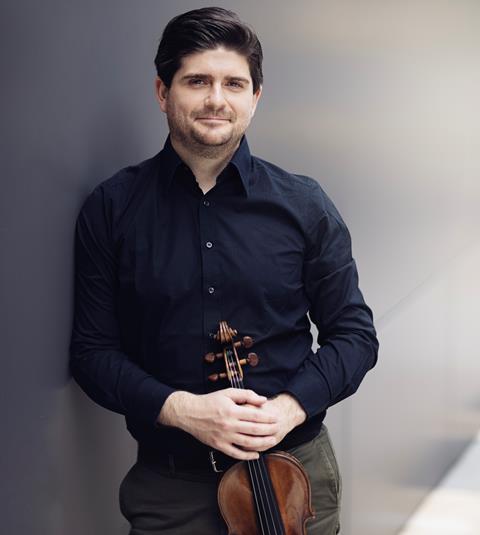How does one conduct violin concertos by Prokofiev, Brahms, Tchaikovsky and Khachaturian - and play the solo part as well? French-Russian violinist Fedor Rudin shares his approach

’Play and Conduct’ is a term that one hears and reads more and more often in concert brochures these days. However, the procedure itself is much older than the profession of a conductor. In the past, just like orchestral pieces, numerous premieres of instrumental concerti were played without a conductor, coordinated between concertmaster and soloist. Performing Prokofiev’s Violin Concerto no.1 in this way with the Orquestra Petrobras in Rio de Janeiro was an exciting experience for me. The general tasks were often similar to the concerti of Mozart or Beethoven, but as the soloist in a concert performance of such a piece, you are still faced with completely different challenges to those you find in music from the Classical period.
Other post-Classical concertos I have played without a conductor include Brahms, Tchaikovsky and Khachaturian - concertos which are actually not all that difficult to ‘lead’ in concert, due to the fairly clear tempo changes and instrumentation and the almost always ’leading’ role of the solo violin.
But particularly demanding for concert performances of repertoire such as Prokofiev’s First Violin Concerto are the abrupt changes in tempo and metre, the polyrhythmy, the disappearance of the harmonic and rhythmical reference points and bases, and the completely different treatment of the wind instruments and of percussion than is found in the classical period, which also plays a certain acoustic role for a soloist surrounded by strings.
I actually prepared myself in the same way as for an orchestral project where you work only as a conductor, and I did spend one rehearsal working with the orchestra without the solo part. Playing orchestral and chamber music are of course very similar tasks, yet the first often approaches the second even more when there is no conductor on the podium. Although I had already played the concerto, I began to analyse the score again and immediately focus on understanding which instrument or group of instruments would have a leading role at which point. In such a case, you deal with the piece in much more detail than usual. Not that for a performance with a conductor you don’t have to have any clue about what the other 80 musicians in the orchestra are playing, but by creating a rehearsal plan and having to organise certain parts for a concert performance, you then simply know the score better and can feel even more controlled and relaxed while playing the solo part.
Listen:The Strad Podcast Episode #24: Caroline Pether on the joy of playing in chamber orchestras
Listen: The Strad Podcast Episode #29: Julia Fischer on Mozart Violin Concertos
There are three interesting problems of body language for conducting while holding a violin and a bow. First of all, it is difficult to go straight from the solo part to ’conducting’ for a very simple technical reason: every note and/or sound of a string instrument needs an ‘end’, where you really shouldn’t take the bow from the string too quickly, and certainly not do so to conduct. Unfortunately, the strings don’t have a right pedal that could be easily pressed at precisely these moments. Therefore, there is always a small time gap between the end of a solo and taking over the conducting in the concert, which, for example, requires a different method in the event of a sudden change in tempo: a combination of a light and precise use of body language from the soloist already in the upbeat or even earlier, together with a conscious action of a particular instrument group responsible for the change of tempo in the orchestra.
Secondly, a bow is not a conducting baton. It’s also a long piece of wood, but it doesn’t have the qualities at all to reinforce the point for timing information with the tip like a baton has, being built completely differently, having a different centre of gravity and mass distribution, it does more harm to conducting information than it helps. Therefore it is actually desirable whenever possible to take the bow together with the violin in the left hand in order to conduct with the right hand only.
Last but not least, a soloist often has to deal with demanding, complicated passages and must also be able to still take the orchestra along emotionally, maintaining both the tension and a certain level of control. In these moments, when a soloist needs well-organised multitasking, it is important that everything that concerns the purely ’mechanical’ instrumental playing happens completely automatically, so that one can simultaneously concentrate on other musical elements or instrumental entries. It does not necessarily apply to fast and virtuoso passages, but to passages that at first glance appear very simple instrumentally, but are much more difficult to realize in combination with other tasks. In these moments, you really need to be able to put the solo playing on ’autopilot’. One last aspect: orchestras sometimes tend to drag on long notes, all the more so if there is no conductor. For us it means only one thing: to be on the safe side in concert, always save as much bow as possible!
Fedor Rudin and Boris Kusnezow’s album ‘Heritage’, featuring works for violin and piano by Denisov, Debussy, Shostakovich and Prokofiev is out now on Orchid Classics.











































1 Readers' comment